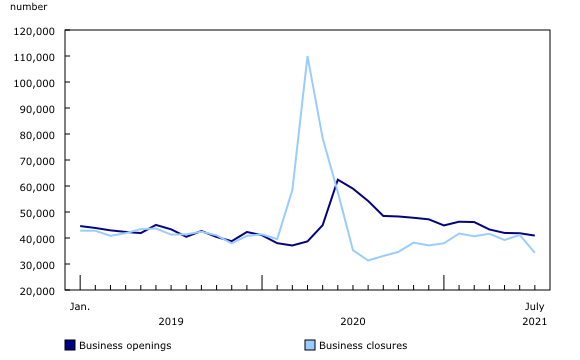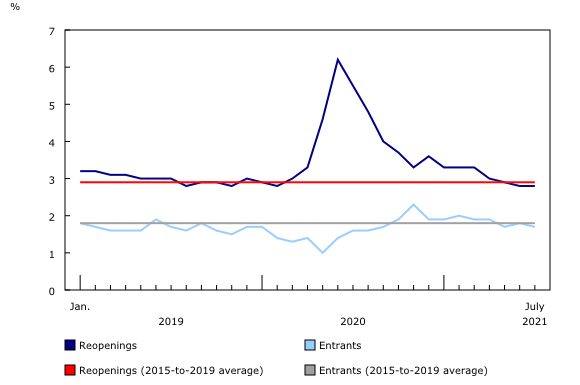Monthly estimates of business openings and closures, July 2021
Archived Content
Information identified as archived is provided for reference, research or recordkeeping purposes. It is not subject to the Government of Canada Web Standards and has not been altered or updated since it was archived. Please "contact us" to request a format other than those available.
Released: 2021-10-25
The number of business closures decreased by 16.7% in July, the highest percentage change since July 2020. Meanwhile, business openings declined slightly, by 2.1%. As a result, the number of active businesses grew by 0.1% in July.
The number of active businesses has been increasing since June 2020 and has been above its pre-pandemic level of February 2020 for three consecutive months, suggesting a sustained recovery following the easing of public health restrictions.
The decline in business openings (-2.1%) was entirely driven by a lower number of entrants (-6.4%) in July compared with June. However, opening, reopening and entry rates were close to their respective 2015-to-2019 averages.
The number of business closures dropped or was little changed in every province and territory in July, with the exception of Alberta (+0.5%; +25) and British Columbia (+4.7%; +306). Ontario (-29.6%; -5,183), which drove the decline, and Manitoba (-25.6%; -349) showed their highest percentage decreases in business closures since August 2020.
Business closures are below their pre-pandemic levels in the tourism and accommodation and food services sectors for the first time since November
Business closures dropped in the tourism (-10.5%; -327) and accommodation and food services (-12.4%; -298) sectors in July and were below their pre-pandemic levels for the first time since November 2020. This was the result of three consecutive months of decline in these sectors. The overall decrease in business closures in July was driven by the drop in other services (except public administration), which was 32.7% (-1,037) lower than in June.
Openings in other services (except public administration) rose by 57.0% (+1,477) in July, partly because personal care services resumed in Ontario and Manitoba at the end of June. The number of business openings in construction (-4.0%; -218), which has generally been declining since August 2020, was below its pre-pandemic level for the first time since April 2020.
The change in the number of active businesses varied across industries. Among the sectors most affected by the pandemic, the tourism and the accommodation and food services sectors showed a higher number of active businesses for the second straight month in July, reducing the gap with their respective pre-pandemic levels.
Note to readers
Every new month of data leads to a revision of the previously released data due to factors such as the seasonal adjustment process and a new version of the Generic Survey Universe File (vintage of the Business Register). As such, estimates may vary from a previous release.
Openings are defined as businesses with employment in the current month and no employment in the previous month, while closures are defined as businesses that had employment in the previous month, but no employment in the current month. Continuing businesses are those that have employees in both months, and the active population in any given month is the number of opening and continuing businesses in that month. Reopening businesses are defined as opening businesses that were also active in a previous month (that is, they closed in a given month and had positive employment in a subsequent month). In contrast, entrants are opening businesses that were not active in a previous month.
A business is defined as an enterprise operating in a particular geography and industry.
The vast majority of businesses operate in one industry and one location or geography. For these businesses, in the monthly estimates of openings and closings, they will be counted once at the national/provincial level. For example, a retailer in Windsor, Ontario will be counted as an active business in the Ontario estimates and once in the national estimates.
Some businesses can have multiple operations, and these can be in different industries and geographies. For such businesses, in the monthly estimates of openings and closings, they can be counted more than once because they are active in multiple industries or geographies. For example, if a retailer has operations in both Alberta and Ontario, it will be counted as an active business in both provinces, but only once at the national level because it represents only one active firm. Similarly, a firm with retail and wholesale operations will be counted in both industries when individual industries are examined. However, when the business sector is examined, the firm counts only once because, at that level, it represents one firm active in the business sector.
Contact information
For more information, or to enquire about the concepts, methods or data quality of this release, contact us (toll-free 1-800-263-1136; 514-283-8300; STATCAN.infostats-infostats.STATCAN@canada.ca) or Media Relations (613-951-4636; STATCAN.mediahotline-ligneinfomedias.STATCAN@canada.ca).
- Date modified:



